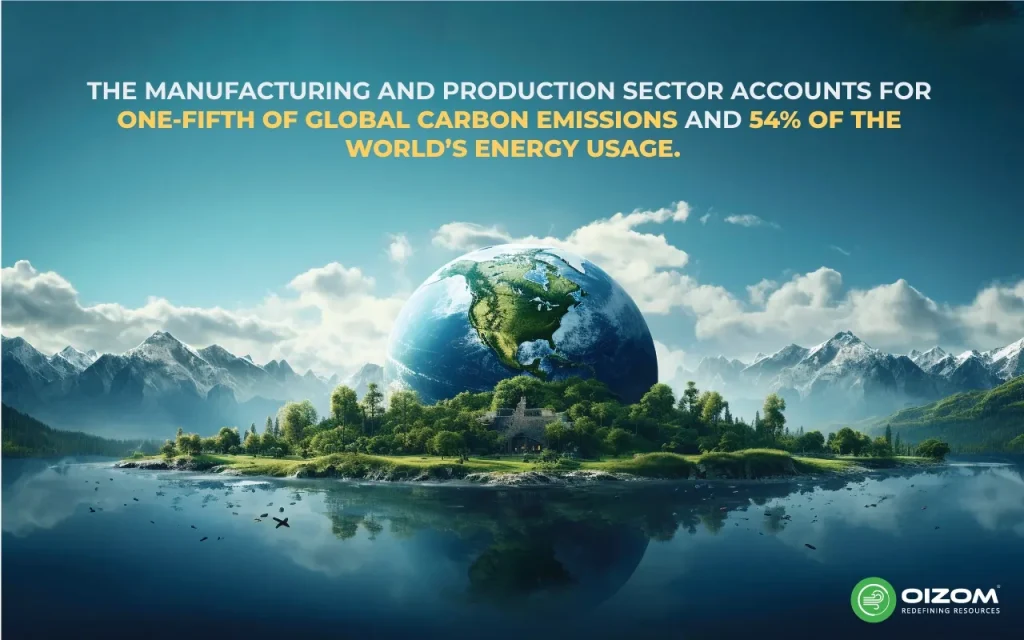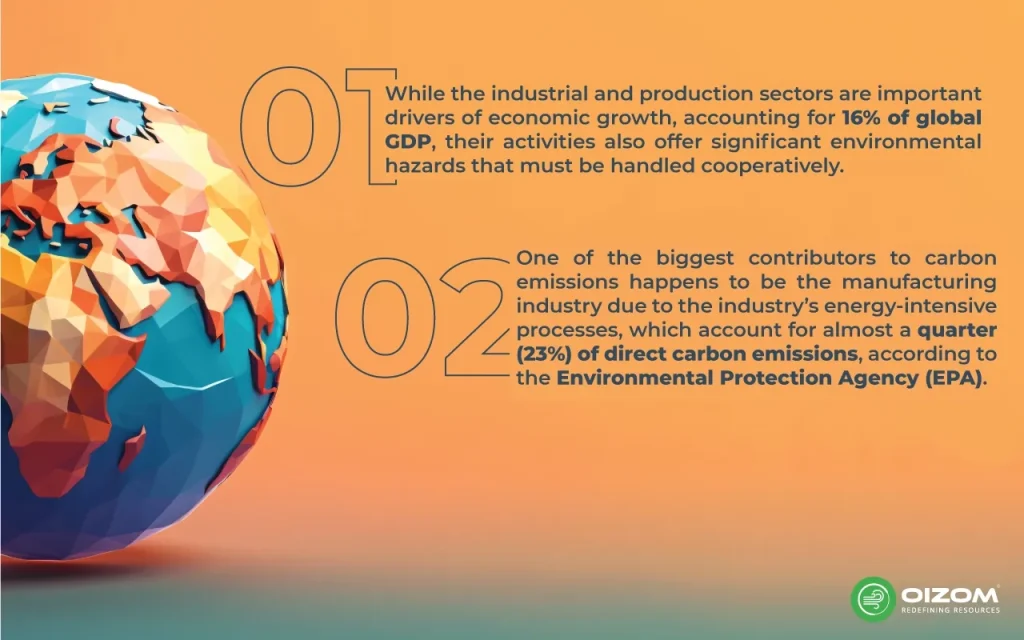
The manufacturing and production sector accounts for one-fifth of global carbon emissions and 54% of the world’s energy usage. All industries contribute to CO2 emissions, and it’s old news that this isn’t great for the environment. Reducing carbon emissions from the manufacturing sector is critical to meeting global climate targets; however, the benefits of carbon management go beyond sustainability for manufacturers. Manufacturers who control their carbon emissions will comply with current and future legislation, reduce waste, and boost efficiency. Moreover, various air quality monitoring techniques are available for monitoring CO2 emissions.
This is not merely about meeting regulations but ensuring the industry’s sustainability and continued economic contribution. The challenge of reducing carbon emissions offers an opportunity for manufacturers to adopt innovative, greener practices that not only mitigate environmental impact but also enhance efficiency and competitiveness. However, there is an urgent need for manufacturing companies to address the challenges of decarbonization. In this blog, we will discuss the following. what are common carbon management challenges in manufacturing? with relevant strategies for carbon reduction? Here are some common challenges, effective solutions, and useful tools to reduce manufacturer carbon emissions.
Common carbon management challenges in manufacturing
Carbon management begins with carbon computation since, as the familiar goes, you can’t manage what you can’t quantify. However, one of the most common carbon management issues is correctly and thoroughly calculating emissions. While the industrial and production sectors are important drivers of economic growth, accounting for 16% of global GDP, their activities also offer significant environmental hazards that must be handled cooperatively.
Manufacturers frequently have complex, worldwide value chains. Their suppliers are spread throughout the globe, and the emissions data they provide may be of poor quality – assuming they track any data at all. This can make it difficult for manufacturers to gather the information required to assess their value chain emissions. If any manufacturing has been outsourced, the data collection necessary to calculate emissions becomes even more complicated, as many different products can be manufactured for different clients at the same factory. The consequences of poor emissions calculations are far-reaching.
One of the biggest contributors to carbon emissions happens to be the manufacturing industry due to the industry’s energy-intensive processes, which account for almost a quarter (23%) of direct carbon emissions, according to the Environmental Protection Agency (EPA).

Key Strategies for Carbon Reduction:
Three key strategies stand out in the quest for carbon reduction within the manufacturing sector: energy efficiency and optimization, sustainable materials and procurement, and adopting circular economy principles. Each of these approaches offers a pathway towards significant reductions in carbon emissions, contributing to the global effort against climate change.
Energy Efficiency and Optimization
Improving energy efficiency across manufacturing processes is one of the most direct methods to cut carbon emissions. This can be achieved by upgrading to more energy-efficient machinery, implementing smart systems for better energy management, and optimizing production workflows to minimize waste and reduce energy consumption. Such initiatives lower carbon footprints and lead to substantial cost savings over time, creating a win-win scenario for manufacturers and the environment.
Sustainable Materials and Procurement
By incorporating sustainable materials into their manufacturing processes, chemical firms can lower their carbon footprint. This can involve using biodegradable and non-toxic materials and incorporating recycled resources into manufacturing. Furthermore, sustainable materials can help to minimize carbon emissions by lowering the demand for new raw materials and trash. In recent years, there has been a growing trend towards using sustainable materials in chemical manufacturing as companies recognize the importance of reducing their environmental footprint and the potential economic benefits of adopting sustainable practices.
Circular Economy Principles
Lastly, embracing the principles of the circular economy can profoundly transform manufacturing towards sustainability. Chemical producers may utilize circular economy models to reduce waste and maximize resource utilization. This strategy can include reusing materials and products, recycling waste, and recovering energy from waste. By embracing circular economy concepts, chemical firms can lower their carbon impact.
Design for disassembly and reuse
Designing for disassembly and reuse is an important method for minimizing carbon emissions in manufacturing. This strategy entails designing goods that can be simply disassembled at the end of their lifespan, allowing components and materials to be reused or repurposed. Such design choices make it easier to repair, refurbish, and recycle, considerably reducing waste and the demand for new raw materials and, therefore, lowering the carbon footprint of manufacturing.
Implement robust recycling and waste management systems:
Implement waste reduction techniques in the office to reduce garbage entering landfills. This can be accomplished by implementing a thorough recycling program, forming a green team to undertake annual waste audits, recycling electronic equipment, becoming paperless, and prohibiting plastic bottles. In addition, encourage litter-free meals and work with suppliers to ensure packaging is made of recycled materials.
Develop closed-loop manufacturing systems:
In a closed-loop system, waste materials from the manufacturing process are recaptured, recycled, and reused to produce new products. This approach minimizes waste and maximizes resource efficiency, leading to a substantial reduction in carbon emissions. Closed-loop systems exemplify the circular economy in action, showcasing how manufacturers can operate sustainably while still meeting the demands of the global economy.
Operational and System Improvements:
Operational and system improvements are critical for manufacturers with lower carbon footprints. Companies can increase their efficiency significantly by optimizing production processes, implementing innovative technology, and improving energy management. Predictive maintenance, efficient energy use, and lean manufacturing are all examples of operational changes that minimize waste and resource use while simultaneously lowering carbon emissions. Similarly, system advancements such as using renewable energy sources, smart grids, and automation help create a more sustainable manufacturing environment. These advancements help with decarbonization initiatives, resulting in cost savings and greater market competitiveness.
Enabling Factors for Successful Decarbonization:
For successful decarbonization, several enabling factors are essential. First, commitment from leadership to embed sustainability into the core business strategy is critical. This commitment must be supported by investments in green technologies and employee training to foster a culture of sustainability. Additionally, access to reliable data and analytics is vital for monitoring progress and identifying opportunities for further carbon reduction. Monitoring Air Quality with Oizom devices such as AQbot is an industrial-grade single parameter with a buzzer feature and memory for six months of in-device data backup, providing real-time data on the Envizom software module. The alarm sounds, ensuring workers’ safety.
The collaboration across the value chain, including suppliers, customers, and regulatory bodies, enhances the impact of decarbonization efforts. Furthermore, leveraging financial mechanisms and incentives for green investments can accelerate the transition to low-carbon operations. These enabling factors, combined with a proactive approach to operational and system improvements, form the foundation for manufacturers to achieve their decarbonization goals effectively.
Conclusion
Finally, manufacturers are critical in lowering global greenhouse gas emissions and combating climate change. Adopting sustainable and ecologically responsible methods is a moral responsibility and a sound business decision in today’s world. Manufacturers can significantly reduce their carbon footprint by setting ambitious targets using the key strategies for carbon reduction with sustainable materials and processes of adopting circular economy principles. Finally, the success of these initiatives will necessitate a collaborative strategy, including all stakeholders, including manufacturers, governments, consumers, and investors, working together to create a sustainable future for generations to come.
FAQs
Manufacturing contributes about 20% to 30% of global carbon emissions, with the highest emissions coming from industries like steel, cement, and chemicals. This varies by country and the green technologies adopted.
Manufacturers can lower emissions by:
- Improving Energy Efficiency: Using less energy through better processes and equipment.
- Using Renewable Energy: Switching to solar, wind, or hydropower.
- Choosing Sustainable Materials: Opting for materials with lower environmental impact.
- Adopting Circular Economy: Recycling, reusing, and designing for product longevity.
- Optimizing Processes: Leveraging technology for more efficient production.
- Implementing Carbon Capture: Capturing emissions before they enter the atmosphere.
These strategies help manufacturers significantly cut their carbon footprint.






